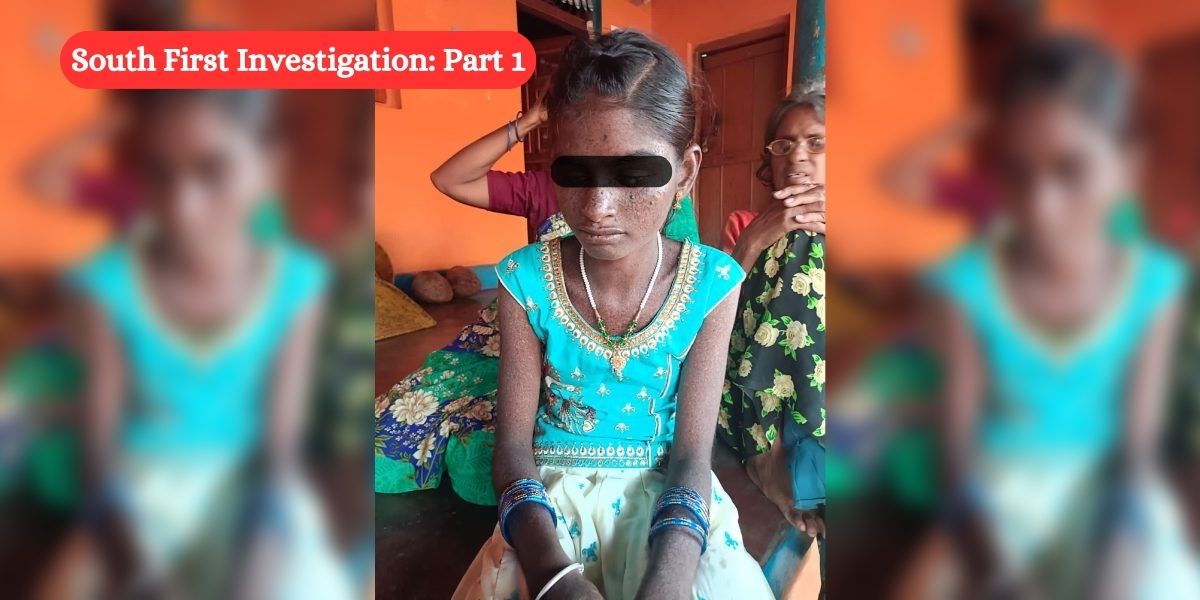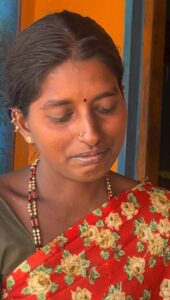A rare genetic condition has been claiming the lives of children in Kuratti Hosur, Bhadrenahalli and Shettalli. More are struggling to stay afloat without medical assistance.

Savitha has three cancers gnawing away at her life. Her parents expect her to have a year or two left to live. (Chetana Belagere/South First)
This is the first of a three-part investigative report on Xeroderma Pigmentosum (XP), a rare genetic condition characterised by extreme sun sensitivity. Several children of three villages in Karnataka’s Chamarajanagar are forced to sequester themselves indoors for an additional lease of life, which the villagers firmly believe, won’t go beyond 18 years. Their belief is based on experience, and hence they are not seeking medical assistance. The children are left to die a miserable death. Ten children, all aged below 18, have died in past decade or so. Five others await death .
The sky was still dark when the rooster announced a new dawn. A few hens clucked in protest. A brief pause later, the rooster crowed again, this time louder and with a renewed resolve.
Kuratti Hosuru village remained still, enveloped in darkness. The darker silhouette of the Male Mahadeshwara Hills rose against the dark sky, tall, imposing, and overlooking the silent village.
Leaves rustled and birds chirped with caution as a gentle breeze swept down the slopes. Hiding somewhere beyond the horizon, the golden sun started painting the night sky. A hint of faded silver appeared up above the mountains.
As time ticked away, the village got its first glimpse of the blue sky. Golden crowns adorned the mountain tops above the verdant slopes.
Several villagers, now awake, still stayed indoors, not letting the sun rays in, hesitant to soak in the glory of a new day. Conspicuously, the clatter of children did not rise over the hamlet.
For some of them, light is sorrow, and darkness, bliss. Each ray of light brings with it the added fear of a sure and impending death. They are the children of darkness.
Savitha had dusky, clear skin at birth, 13 years ago. Unknown to her parents, the child had a “condition”, like several others in the village.
The “condition” soon began manifesting itself on her as dark, pale patches, and freckles covered her limbs and face. Mottled, pigmented spots and adherent scales soon appeared all over her. Her eyeballs, especially the left one, have turned milky white, leaving her with little vision.
Doctors have identified this “condition” as Xeroderma Pigmentosum (XP), a genetic condition characterised by extreme sun sensitivity, leading to a very high risk of skin cancer and other medical problems.
Savitha has three cancers gnawing away at her life. Her parents expect her to have a year — or maybe two — left to live.
Four other children at Kuratti Hosuru in Karnataka’s Chamarajanagar district, too, are facing a similar fate. Each exposure to sunlight further reduces their life.
South First travelled to Kuratti Hosuru to learn more about the condition of the XP-affected children.
Some 4 km ahead of Kuratti Hosuru, Deeksha’s smile radiated innocence and warmth. Hair is growing back on her recently tonsured head. The vertical stripes on her little blue T-shirt looked like several hands reaching up to the sky on a starry night.
The cherubic 15-month-old baby kept smiling from the safety of her mother Sudharani’s protective arms in the Bhadrenahalli village located on the way to Kuratti Hosuru from Bengaluru. Strikingly, the child kept her eyes tightly shut.
Deeksha cries whenever her skin is exposed to the sun, winces, and closes her eyes, as if to shut herself off from the harsh reality.
“My daughter is now one-and-half-years-old. I noticed her refusing to open her eyes to sunlight. She would cry even when the tube lights are switched on at home,” Sudharani said. “Once the lights are switched off at night, the child becomes active.”
The mother was worried when black spots developed on her baby’s chubby cheeks and nose. The spots gradually became bigger and started spreading like ink spilled on a blank canvas.
Elders in the family and the neighbourhood, too, had noticed the spots. They spoke in hushed tones. They have seen the same symptoms in Savitha, Naveen, Heishika, Nagarjun, and Santosh.
They have also seen the same mottles in those children who had died young: Muniyamma, Jayaraju, Jashwanth, Santu…. They realised that the list would grow.
“After noticing the symptoms in Deeksha, the elders told me that she, too, has the same condition that claimed the lives of my elder sister Priyanka’s sons, Jashwanth and Jayaraju,” Sudharani wryly smiled, and held the baby tighter to her bosom.
Sudharani has rarely slept properly ever since spots appeared on Deeksha’s face. She has to cook, send her elder son to school, and take care of the family. Deeksha will remain cocooned indoors, refusing to accept sunlight.
“She has to be carried around all the time. She gets restless and cranky. I don’t know if the condition hurts her. She doesn’t complain but is constantly cranky. It is difficult for me to handle her some days. She won’t even eat properly,” Sudharani sighed.
Deekhsha’s family has decided not to take her to a doctor.
“It’s pointless. She won’t live beyond 13 years,” the young mother said. The baby gave a charming smile, eyes shut. Outside the village, society, too, has its eyes shut to Deeksha’s condition.
Deeksha’s family has a reason to avoid medical treatment. “There is no treatment for her condition. Doctors told my sister that her children suffered from this disease as she had married within the family,” Sudharani continued.
“But I don’t believe that justification. We have seen similar cases in which the parents are from different villages and are not blood relations. This is our fate, that’s all,” she tried to remain cheerful.
The reality has hit hard. For outsiders, it is difficult to accept the villagers’ point of view, especially when the mother of a cherubic and bubbly 15-month-old girl says that her baby will not live beyond the age of 13.
At Kuratti Hosuru, in Savitha’s room, thick bedsheets cover the windows and any other openings that may bring the sunlight in.
Up from the bed, Savitha’s movements are cautious and calculated in the dim, depressing room. Stepping outdoors or drawing the curtains to let the light in, are unthinkable. Even a brief exposure to sunlight could cause irreparable damage to her already delicate skin, eyes, and life. Rise and shine is a phrase too alien for her.

Lakshmi fails to hold back tears when she spoke of her daughter Savitha’s condition. (Chetana Belagere)
The child stays confined to her house as she has been doing all these years. Savitha sits in her sun-proofed home, gazing beyond the verandah at the world passing by without her.
Savitha has stepped out occasionally, albeit fleetingly. Each time meticulous and elaborate preparations are made for her to leave the house. When the shadows stretch eastward, and the sun rays become soft and kind, she steps out, gingerly and prepared. It is her only window of opportunity to be in the open and take in fresh air.
All the caution, however, will not help Savitha for long. Her parents are expecting her spirit to soar away soon, leaving them for good.
Her father Basavanna had more immediate concerns. He said while the skin issue doesn’t trouble her much, blisters form in her eyes, causing the eyeball to turn almost white.
“My daughter had good vision. She has no itching or boils that Priyanka’s (Sudharani’s sister) sons had suffered, but her eyesight is a major concern. She can see very little now. She just manages to take care of herself. We hope her eyesight is restored,” Savitha’s mother Lakshmi told South First.
The diminishing eyesight has made Savitha sad, especially since she could not watch her favourite hero, the late Puneet Rajkumar, dance. “I can only listen to his songs now. Watching him on the mobile phone strains my eyes and they start hurting,” she said.
Doing her daily chores, too, has become hard for the girl if her mother or aunt are not around. “Earlier, I used to fill water in the pots. Now I can’t do it,” the teenager added.
Munimadashetty, a retired school teacher, lives a few houses from Savitha. He has lost a daughter and two grandchildren to this rare condition. He even had to prick his daughter’s eye before taking her to a hospital.
(In Part 2 of the South First investigation into Xeroderma Pigmentosum-afflicted children, we take a look at how authorities remain blind to ‘chukki kayle’.)

May 19, 2024

May 19, 2024

May 19, 2024

May 19, 2024

May 18, 2024

May 17, 2024